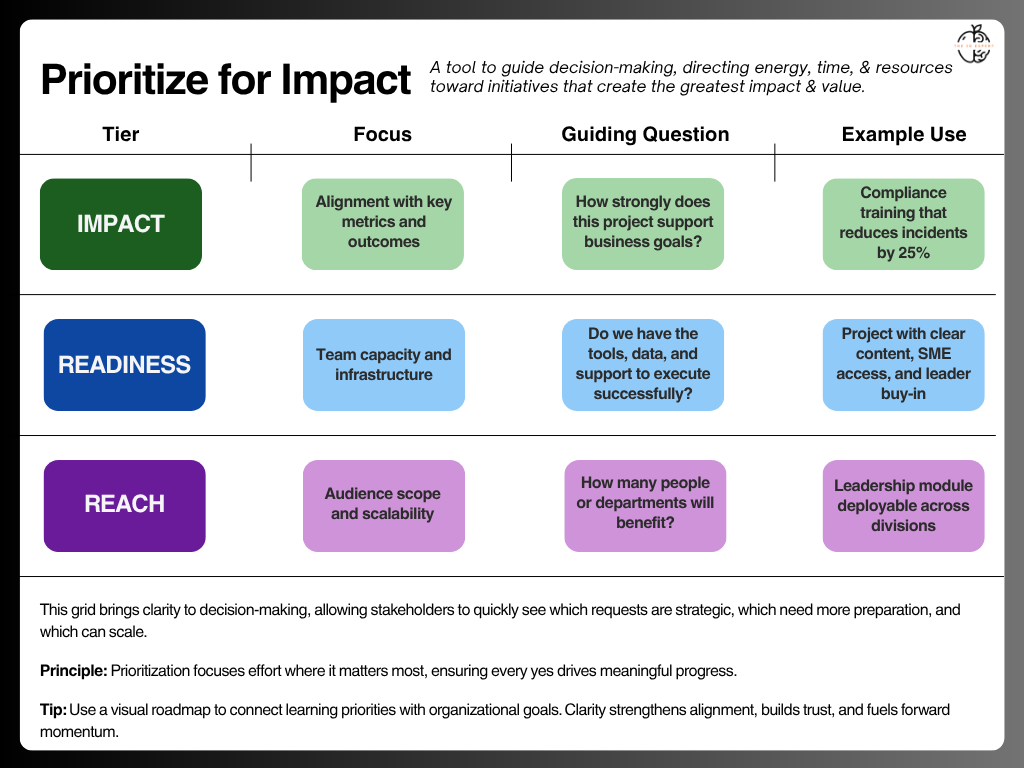Prioritize for Impact: The Art and Neuroscience of Choosing What Matters
The room pulsed with focused energy, screens flickering, ideas overlapping, and voices weaving through a steady rhythm of urgency. Across a sprawling whiteboard, sticky notes bloomed like wildflowers: onboarding, compliance, leadership, mentoring, culture. Each color held meaning, yet together they merged into a blur of ambition.
Every initiative carried weight; however, none carried clarity.
The air felt thick with the hum of effort unanchored by focus, that subtle exhaustion born not from work itself but from the brain’s inability to decide what deserves attention. The prefrontal cortex, the seat of reasoning and direction, was overrun by noise. Emotion and logic had lost their rhythm.
When everything shines equally bright, the mind cannot tell what matters most.
When Urgency Replaces Understanding
In organizations, urgency often masquerades as impact. Every project feels necessary, and every request sounds essential. Yet cognitive science reveals a deeper truth: The brain is built for focus and meaningful sequencing, where attention thrives on what matters most.
According to Immordino-Yang and Damasio (2016), emotion and cognition function as a single system, meaning guides motivation. When purpose blurs, energy scatters. Urgency triggers survival mode, rewarding the nervous system temporarily while quietly eroding direction.
Teams mistake motion for momentum. Decisions multiply and focus fragments. What begins as enthusiasm ends as fatigue.
The greatest leverage comes from discernment, the ability to focus effort where it matters most.
Designing the Conditions for Clarity
When learning and development teams reached the breaking point of competing initiatives, they turned to something deceptively simple: a three-tier framework labeled Impact, Readiness, and Reach.
Impact clarified which initiatives directly advanced strategic goals.
Readiness exposed what needed groundwork before success was possible.
Reach illuminated how widely a project could scale across learners or teams.
Laid out visually, the grid transformed the conversation. What once sounded abstract became visible. Patterns appeared and debates softened into discovery.
Neuroscience explains why.
The human brain processes hierarchy and pattern spatially. Willingham (2023) notes that thinking becomes efficient only when information is structured. Visual grids externalize cognition, reducing cognitive load and increasing coherence.
In the glow of that board, learning teams could finally see alignment emerge from the noise.
The Science of Shared Seeing
When people look at the same visual model, something extraordinary happens.
Research by Stephens, Silbert, and Hasson (2010) shows that neural coupling, a synchronization of brain activity, occurs when individuals share focus and interpretation. This physiological alignment accelerates collaboration and trust.
The Prioritize for Impact grid became that shared map.
Instead of defending projects, teams analyzed patterns together. Instead of protecting priorities, they refined them. The framework turned decision-making into dialogue.
Clarity became less about instruction and more about shared meaning, an act of collective sense-making.
The Emotional Geometry of Focus
When understanding crystallizes, the body responds.
Damasio (2021) describes this as somatic alignment, or the physiological calm that accompanies coherence. The pulse slows and shoulders drop. Thought and feeling rejoin.
Each movement of a project across the grid and every decision from “not yet” to “ready” activated the brain’s reward system. According to Soderstrom and Bjork (2015), visible progress triggers dopamine, reinforcing persistence. The framework offered teams the one thing modern work rarely does: a way to see their own growth.
Clarity, in this sense, became emotional design.
Constraint as Creative Catalyst
Creativity often blooms within boundaries.
When priorities multiply endlessly, imagination suffocates under overload. But when focus narrows to the initiatives that carry both readiness and reach, innovation expands naturally.
Todd Rose (2018) called this the “end of average”: progress born not from doing more but from doing what matters. The Prioritize for Impact framework channels this principle into practice.
By defining constraint, teams rediscovered creativity. Every “no” became an act of stewardship for something more meaningful.
Patterns of Progress
Over time, the grid evolved into a mirror for organizational learning.
High-impact projects shared a distinct DNA: clear sponsorship, measurable outcomes, learner relevance, and a visible line to strategy. Low-impact efforts revealed gaps in readiness or overstretched capacity.
Patterns like these created meta-learning. Teams began anticipating needs, refining process, and designing for sustainability.
Each review of the grid became a reflective practice rather than just another meeting, a chance to interrogate assumptions, surface insight, and recalibrate alignment.
Instructional design, at its core, has always been about this kind of reflection: turning information into insight, and insight into intention.
The Aesthetics of Alignment
Clarity, when fully realized, has an aesthetic quality. It feels like resonance.
Using the framework leads to a “We can finally see where we fit” moment, and this captures what Immordino-Yang (2023) calls emotive coherence: the brain’s experience of harmony when meaning and purpose align.
Carew and Magsamen (2020) describe this phenomenon as aesthetic cognition, the pleasure derived from recognizing pattern and proportion. When work makes sense, it also feels beautiful.
The grid evolves beyond a planning tool into a canvas for collective clarity, where logic and emotion coexisted in harmony.
From Projects to Purpose
In the field of instructional design, we speak often about alignment between learning objectives and outcomes as well as cognition and context. The Prioritize for Impact framework reminds teams to apply that same discipline to themselves.
To prioritize well is to design well, and to align effort with value is to model the very learning process we teach.
Visible priorities make strategy human. They turn focus, empathy, and trust into shared understanding.
The Closing Reflection
Organizations rarely suffer from too little passion, but from passion that disperses before meaning has time to take root.
The Prioritize for Impact framework restores balance.
It invites teams to pause, observe, discern, and transform noise into narrative.
It reframes clarity as an act of care and shows that purposeful prioritization is the highest expression of design thinking.
Learning accelerates through intentional choice, where focus replaces excess and meaning drives momentum.


